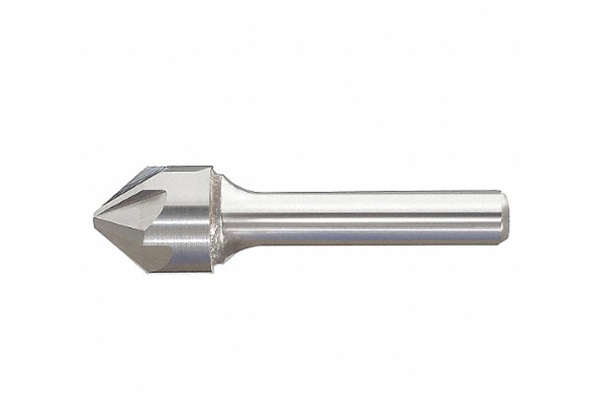Are you looking for a way to create clean, precise countersinks for your projects? This comprehensive guide delves into the world of carbide countersink drill bits, exploring their features, benefits, and how to choose the right one for your needs. From understanding the different types to mastering the techniques, we'll equip you with the knowledge to achieve professional-quality results every time you drill. This article is worth reading because it provides practical advice and expert insights, helping you make informed decisions about your drilling projects.
1. What is a Countersink Drill Bit and Why is It Important?
A countersink drill bit is a specialized drill bit designed to create conical holes, typically to accommodate the head of a screw or bolt, allowing it to sit flush with or below the surface of the material. The primary function of a countersink is to create a recess, providing a clean and professional finish. When you drill, the countersink ensures that the fastener doesn't protrude, preventing snags and enhancing the overall aesthetics of your project.
Using a countersink is crucial in various woodworking, metal work, and construction applications. Without using the proper drill bit, the screw head would stick out, which can be a safety hazard and can detract from the look of your project. Using a countersink offers numerous benefits, including improved aesthetics, enhanced safety, and increased durability of the fastened joint. We drill so that it will stay together. It's very important.
2. Understanding the Different Types of Carbide Drill Bits: Which One is Right for You?
There are several types of drill bits available, each designed for specific materials and applications. When we drill, we need to make sure we are using the proper drill bit. Carbide drill bits are known for their exceptional hardness and wear resistance, making them ideal for demanding projects. The most common types include:
- 82 Degree Countersink: This is a widely used angle, suitable for most common screws and materials. The 82 degree countersink is great for general use.
- Tapered Countersink: A tapered countersink features a conical shape, making it ideal for creating smooth, flush surfaces.
- Adjustable Depth Stop Countersink: This type includes a depth stop mechanism, allowing you to control the depth of the countersink precisely. An adjustable depth stop is a great tool for many jobs.
- Carbide Tipped Countersinks: These are great for durability.
When choosing a drill bit, consider the material you'll be working with. A carbide drill bit will excel when working with hard materials, while an HSS (high-speed steel) bit might be more suitable for softer materials. Selecting the right drill bit is a must.
3. Carbide vs. HSS: Choosing the Best Material for Your Drilling Needs
The choice between carbide and HSS drill bits depends on the specific application and the material you plan to drill. Carbide is superior in hardness and wear resistance, making it ideal for hard materials like metal, hardwoods, and composites. Carbide drill bits excel in demanding applications where tool life and precision are paramount. This is something you need to consider when you drill.
HSS (high-speed steel) drill bits, on the other hand, are more cost-effective and suitable for softer materials like wood and plastics. While they may not last as long as carbide bits, they are easier to sharpen and are a good choice for occasional use or less demanding projects. Understanding the difference is a key to the best results when you drill.
- Carbide:
- Advantages: Extremely hard, long-lasting, ideal for hard materials, maintains a sharp cutting edge.
- Disadvantages: More expensive, can be brittle if not used correctly.
- HSS (High-Speed Steel):
- Advantages: More affordable, suitable for softer materials, easier to sharpen.
- Disadvantages: Less durable, wears down faster when drilling hard materials.
4. Key Features to Look for in a High-Quality Carbide Countersink
When selecting a carbide countersink drill bit, several features can impact performance and longevity. Here are the key features to consider:
- Material: Ensure the bit is made of high-quality tungsten carbide for superior hardness and wear resistance.
- Shank: Look for a hex shank for secure grip and compatibility with quick-change chucks. A hex shank is a great feature. Some bits feature an inch quick release hex shank.
- Angle: The standard 82 degree countersink is suitable for most applications.
- Cutting Edges: Bits with multiple flutes often provide smoother cuts and better debris away.
- Depth Stop: An adjustable depth stop allows for precise control over the countersink depth. The depth stop will help.
- Low Friction: A low friction coating on the bit reduces heat and friction, extending tool life and improving performance. A low friction coating is a great feature.
- No-Thrust Ball Bearing: An adjustable depth stop with no-thrust is a great feature. This will help to prevent burning of the work material.
Considering these features will help you find a carbide countersink that delivers exceptional performance and longevity. Remember, when you drill, you are making an investment.
5. Mastering the Art of Countersinking: Tips and Techniques
To achieve clean and accurate countersinks, follow these tips and techniques:
- Pilot Hole: Always start with a pilot hole. This helps guide the countersink and prevents the material from splitting. The pilot hole is essential, so drill a pilot hole first.
- Speed and Feed: Use a moderate speed and feed rate to prevent overheating and premature wear of the drill bit.
- Pressure: Apply consistent and even pressure. Avoid excessive force, which can damage the bit or the material.
- Clean Cuts: Make sure your drill bit is sharp and in good condition. Dull bits can cause ragged edges.
- Test: Test your countersink on a scrap piece of material to ensure the fit and depth are correct before working on your final project.
By following these techniques, you can achieve professional-quality countersinks every time.
6. Using a Depth Stop for Precision Countersinking
A depth stop is an invaluable tool for achieving consistent and precise countersinks. An adjustable depth stop allows you to set the desired depth and prevents you from drilling too deep, ensuring that the screw head sits perfectly flush. With an adjustable depth stop with no-thrust, you get the perfect results.
- Adjust the Depth: Adjust the depth stop to the desired depth based on the screw head and material thickness.
- Secure the Stop: Tighten the set screw on the depth stop to secure it in place.
- Countersink: Drill until the depth stop prevents further penetration.
Using a depth stop eliminates guesswork and ensures uniformity in your countersinks, saving time and material while improving the overall quality of your work.
7. Maintaining and Extending the Life of Your Carbide Drill Bit
Proper maintenance is crucial to extend the life and tool life of your carbide drill bit. Here are some tips:
- Clean After Use: Remove any debris or material buildup after each use to prevent corrosion and ensure the bit remains sharp. This keeps your drill bit cutting.
- Avoid Overheating: Allow the bit to cool down between uses, especially when drilling hard materials.
- Store Properly: Store your drill bits in a protective case or rack to prevent damage.
- Sharpening: While carbide is very hard, it can dull over time. Although you may need specialized equipment, consider sharpening your carbide drill bits if they become dull.
By following these maintenance tips, you can maximize the longevity of your carbide drill bits.
8. Top Carbide Countersink Drill Bits and Brands in the Market
Several brands are known for producing high-quality carbide countersink drill bits. Here are a few of the top brands and some recommended products:
- Amana Tool: Amana Tool is renowned for its precision and durability. The Amana tool 55227 carbide tipped is an excellent choice.
- Whiteside Router Bits: Known for their reliable performance.
- Lee Valley: Offers a range of high-quality drilling tools.
- IRWIN: Provides a variety of drilling tools, including countersinks.
- DEWALT: Offers durable and effective drilling tools.
When choosing a carbide countersink, consider the brand's reputation, the bit's features, and the intended application. Reading customer reviews and comparing specifications can help you make the best countersink choice.
9. Applications of Carbide Countersinking: Where Are They Used in Industrial Settings?
Carbide countersinking is a versatile technique used across various industries. Some common applications include:
- Woodworking: Creating flush screw holes in furniture, cabinetry, and other woodworking projects.
- Metalworking: Countersinking holes for screws and rivets in metal fabrication, metal work, and machine parts.
- Construction: Installing fasteners in decking, framing, and other structural components.
- Aerospace: Precisely countersinking holes in aircraft components for a secure fit.
- Automotive: Creating flush mounting points in vehicle assembly and repair.
Carbide drill bits excel in these and many other applications, providing precise and durable countersinks. The applications are nearly limitless.
10. Making Informed Decisions: Selecting the Right Carbide Drill Bit for Your Project
To select the right carbide drill bit for your project, consider these factors:
- Material: Choose a carbide bit for hard materials and HSS for softer materials.
- Screw Type: Match the bit angle to the screw head angle (e.g., 82 degree countersink for most screws).
- Project Requirements: Consider the desired finish, precision, and the number of holes to be drilled.
- Bit Quality: Select a high-quality bit from a reputable brand to ensure performance and longevity.
- Features: Consider features like a hex shank, depth stop, and low friction coating for ease of use and precision.
By considering these factors, you can choose a carbide countersink that delivers the best results for your specific needs, making you much more effective when you drill. The right carbide drill bit is out there!
Here are the key takeaways to remember:
- Carbide countersink drill bits are essential for creating flush, professional-looking screw holes.
- Choose the right type of bit (82 degree countersink, tapered countersink, etc.) for your material and application.
- Carbide is the best choice for hard materials, while HSS is suitable for softer materials.
- Look for quality features like a hex shank, depth stop, and low friction coating.
- Use proper techniques, including a pilot hole and consistent pressure, to achieve the best results.
This comprehensive guide should provide you with everything you need to select and use carbide countersink drill bits effectively. Good luck with your projects! To learn more about our self-drilling anchor systems and drilling tools, please visit our website. We are a leading factory, with 7 production lines to ensure quality and production. We offer a variety of products, including Self-drilling Hollow Anchor, Tapered drill pipe, and Rock Drilling Bits.
Post time: 2 月-07-2025















